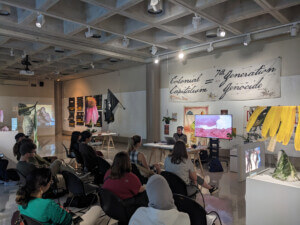The following text was drafted in response to the initial prompt in AN’s “Post-Pandemic Potentials” series. Read more about the series here.
When university classes moved online in March, I felt apprehensive about teaching remotely. Six months later, it turns out that teaching architecture online is not only possible but even offers some advantages. Pleasantly surprised as I was, I don’t wish to reify the dichotomy between remote and in-person learning, as the recent debates around the efficacy of web-based education have. Rather, I am arguing for a hybrid of both models.
Hybrid forms of learning have been around for years, often relegated to skill-building or as a last resort for traveling professors. The pandemic, however, forced their adoption by administrators and educators. For instance, the schools where I teach, Columbia GSAPP and the Yale School of Architecture, have adopted a hybrid approach for the fall semester. Over the summer, GSAPP also launched the web-based Skills Trails platform that builds on the precepts of the “flipped classroom,” whereby pre-recorded, freely accessible tutorial videos open up class time for discussion. Skills Trails and other public platforms like it allow students to learn at their own pace, on campus or off.
The potential for change is huge, up to and including that bedrock of architectural education: the studio. The object of countless memes and inside jokes, studio culture is known to be a relentless slog, involving high rates of production on unreasonable schedules. Space is tight, and physical attendance an unquestioned norm. If the studio environment cultivates camaraderie and mutual inspiration, it also breeds distraction, reinforces elitist attitudes of privilege and exclusion, and, in the time of COVID-19, spreads infection. The opportunities opened to us in recent months posit an alternative, open-door studio, where students have the option to choose their work setting, depending on their needs.
I have tried to illustrate and expand on a hybrid model through the following set of strategies. I have been testing them out since the spring and plan on developing them further over the months—years?—ahead.
1. The flipped classroom
Perhaps the most exciting feature of the hybrid, or blended, learning model is the ability to record and distribute class content outside of class time. Educators can pre-record lectures and spend class time working directly with students. Students can watch or read the content at their own pace and in their own time, and the content can even be published online for wider audiences. It was in this spirit that GSAPP launched Skills Trails, created by my colleague Dan Taeyoung, whose Metatool visual studies class had already been operating along these lines well before campus closed in the spring.
One big hurdle, however, is the upfront time it takes to adapt a course or lecture for an online format. For adjunct professors, in particular, the extra effort is not covered by the current compensation model, which still pays based on the number of hours an educator is supposed to spend teaching a class face-to-face. Moreover, for adjuncts who might be hired for a single semester, it might not be feasible to record high-quality lectures that can be simply repurposed in future iterations of the course. While already widely used, the flipped classroom therefore would need to be implemented at the administrative level and so be adopted in a manner that is sustainable for both faculty and students.
2. The 24-hour virtual studio
In the past half year, we have become all too familiar with video conference portals, yet they can be used for much more than periodical check-ins or meetings. For example, a Zoom channel can be treated as a permanently open “room” where students or faculty can log on and see who is around and have an informal chat; they may even choose to keep it open while they work. At GSAPP, we tested this approach in our Intro to Architecture course and received a very positive response from students. It could work for hybrid studios as well, where some students are remote and need the sense of support and connection that a physical studio setting fosters.
3. (A)synchronous communication
The number of those same communication channels is staggering, and it can sometimes be hard to optimize their use. An important concept to keep in mind is to differentiate between synchronous and asynchronous communication methods. All in-person education is synchronous, since talking to another person gives you real-time information that requires a more-or-less immediate response. Asynchronous communication, by contrast, requires no such feedback, meaning you can work and engage at your own pace. Depending on how they are used, online tools can fall into both categories. (For example, an asynchronous method like email is routinely treated as a synchronous mode of communication, where people are expected to respond immediately.) It seems like synchronous communication would always be preferable as it is immediate, but it leads to a constant sense of busyness, without allowing for deep work and concentration. When setting up a hybrid class, it is crucial to establish expectations about response times, feedback hours, and which channels are best suited to what form of communication.
4. Amplifying voices
As my colleagues and I noticed after migrating to remote learning, educators were able to offer students the option to communicate outside of traditional synchronous verbal communication. In seminars, for instance, students can use chat software to share an idea or a link (or just as often, a meme) with others. In my experience, outgoing and talkative students will translate those traits onto video conference platforms, but the added option of communication via chat opens up additional channels to students who might have a harder time speaking up.
5. 3D scanning
3D scanning has become increasingly accessible over the past few years, requiring little more than a phone camera and laptop. Scans are an immediate way to mediate between physical and virtual environments, allowing students to scan architectural models, environments, or even urban conditions and use them for purposes of documentation or to share with their peers and beyond. The option to upload these models to the web adds another level of interactivity and shareability. For example, these models can then be seen on the web or in VR, downloaded for use by another student, or incorporated into real-time game engines.
6. Virtual reality as a social experience
VR is inherently immersive and therefore uniquely suited to architectural representation. Web platforms like Mozilla hubs enable a dual experience, where users can access spatial environments from their desktops as well as with their VR goggles. For studio reviews, this presents an exciting opportunity where students can interact in the spaces they have designed in real-time. What’s more, the workflow is relatively simple without the need for specialized gaming software.
As I hope I’ve made clear, I do not advocate a shift to remote instruction only. Even if remote learning might seem more effective in the short-term, I strongly believe that education is very much about what happens outside the classroom. Virtual tools will never fully replace human interaction. Nor should we ignore the threat that data harvesting by universities poses to us educators. (On this score, nascent organizations such as Dark Matter University and Dark Study promise to take advantage of networked models to decenter and dismantle traditional hierarchical structures in education.) Nevertheless, hybrid teaching, if combined with other necessary reforms, holds great promise for rethinking architectural education.











